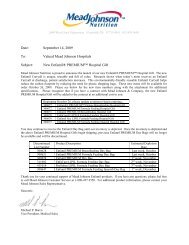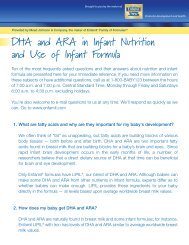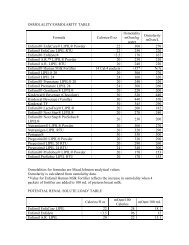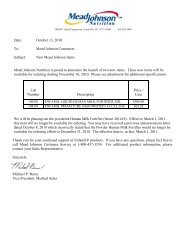LB2882MaternalNutriti+ - Mead Johnson Nutrition
LB2882MaternalNutriti+ - Mead Johnson Nutrition
LB2882MaternalNutriti+ - Mead Johnson Nutrition
Create successful ePaper yourself
Turn your PDF publications into a flip-book with our unique Google optimized e-Paper software.
TAbLE 4. RECOMMENDATIONS FOR ADDITIONAL DAILY CALORIE INTAkE DURING PREGNANCY AND<br />
LACTATION 5,6,67<br />
Pregnancy IOM FAO/WHO/UNU<br />
1 st Trimester 0 85<br />
2 nd Trimester 340 285<br />
3 rd Trimester 450 475<br />
Lactation<br />
1 st 6 Months 330 505 a<br />
2 nd 6 Months 400 Varies depending on milk output<br />
a For women with adequate gestational weight gain. The recommendations for undernourished women and those with insuffi cient gestational<br />
weight gain is 675 kcal/d.<br />
Carbohydrate<br />
The primary role of dietary carbohydrate is to provide energy to cells. Sugars and starches supply energy in the<br />
form of glucose, which is the only energy source for red blood cells and is the preferred energy source for the brain,<br />
central nervous system, and fetus. 5 The U.S. Dietary Reference Intake (DRI) for carbohydrate for a pregnant woman<br />
19 to 50 years of age is a minimum of 175 grams of carbohydrate daily to provide adequate glucose for her body<br />
and for a single fetus. 5 This represents a daily increase of 45 grams above the non-pregnancy state and is easily<br />
achieved by most pregnant women who are eating a balanced diet. The DRI for lactation is higher (210 grams daily)<br />
to compensate for the carbohydrate secreted in breast milk. 5<br />
Fiber is non-digestible carbohydrate and lignin found in plant foods. 5 Benefi ts of dietary fi bers include feelings of<br />
fullness and improved laxation, which could help reduce the chances for hemorrhoids during pregnancy. Some<br />
types of dietary fi ber are also associated with lower postprandial blood glucose levels and reduced blood cholesterol<br />
concentrations. The Adequate Intake (AI) for fi ber during pregnancy and lactation is 14 grams per 1,000 calories. 5<br />
Thus, a pregnant woman with an estimated energy requirement of 2,400 calories should consume about 34 grams of<br />
fi ber daily. Most women do not consume enough fi ber and require counseling about including high-fi ber foods in their<br />
diet, such as dried beans and peas, vegetables, fruits, nuts, and whole grains, to meet the suggested intake.<br />
Protein<br />
Protein is a constituent of all cells and a component of enzymes, membranes, transport carriers, and many<br />
hormones. The amino acids from dietary proteins are utilized by the body for endogenous synthesis of structural<br />
proteins as well as enzymes, numerous hormones, immune factors and a plethora of other vital mediators of<br />
physiological function. 5 Pregnancy signifi cantly increases protein needs due to the increase in hormone production<br />
and plasma volume expansion, along with increased tissue formation for the placenta, fetus and breasts. During<br />
lactation, additional protein intake compensates for protein and non-protein nitrogen output in breast milk. 5<br />
The U.S. Dietary Reference Intakes recommended 0.8 g/kg/day of dietary protein for non-pregnant women. Starting<br />
in the second trimester, the recommended protein intake for pregnancy is 1.1 g/kg/day or about 25 g of additional<br />
protein per day. An additional 50 grams a day of protein is suggested for twin pregnancies beginning in the second<br />
trimester. 5 The WHO recommends that pregnant women consume 1, 9 and 31 g of additional protein daily during the<br />
fi rst, second and third trimesters, respectively. 7<br />
MATERNAL NUTRITION 10

















